Drug Resistance Mechanism in Breast Cancer Brain Metastases
VerifiedAdded on 2022/08/18
|10
|2441
|13
AI Summary
Contribute Materials
Your contribution can guide someone’s learning journey. Share your
documents today.
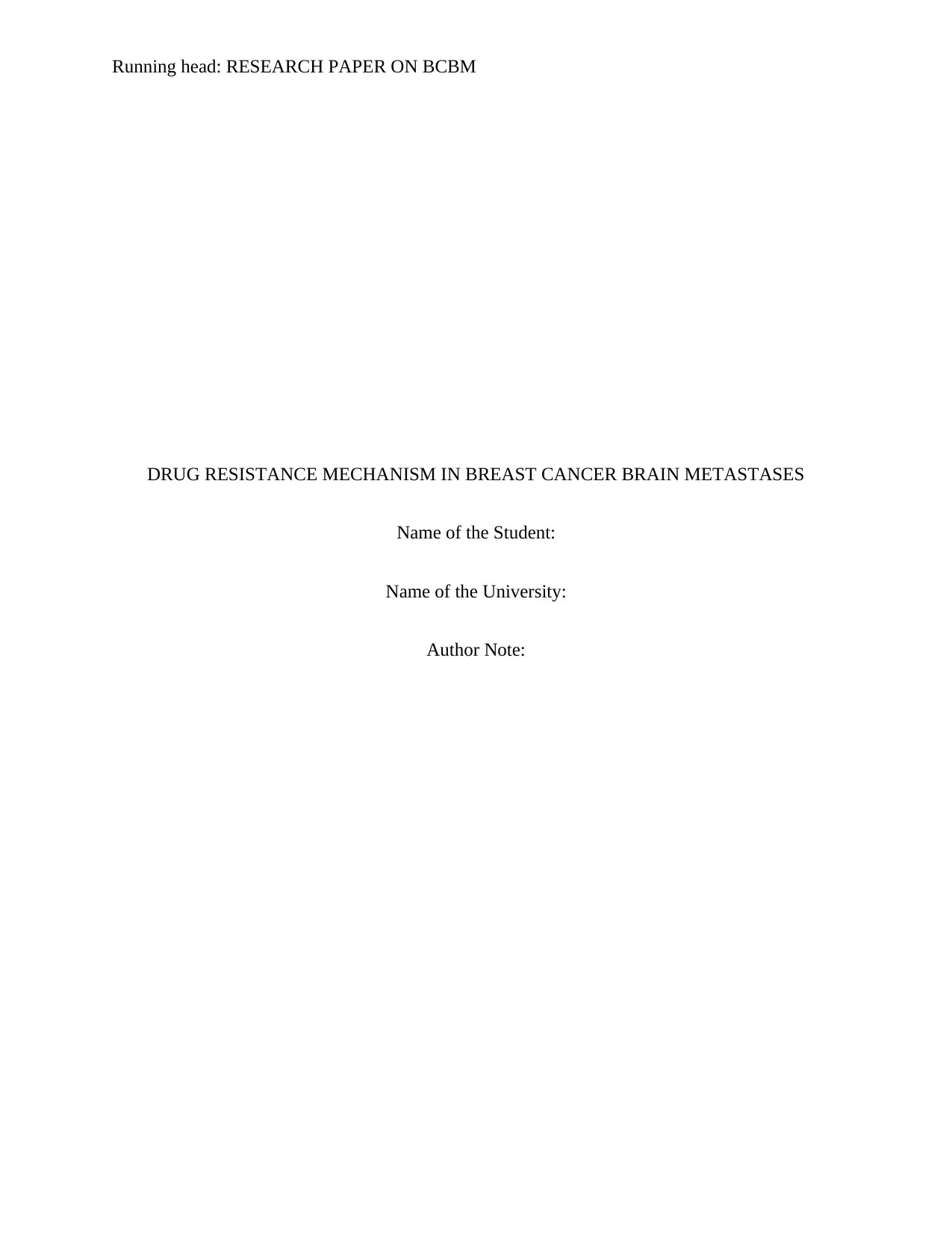
Running head: RESEARCH PAPER ON BCBM
DRUG RESISTANCE MECHANISM IN BREAST CANCER BRAIN METASTASES
Name of the Student:
Name of the University:
Author Note:
DRUG RESISTANCE MECHANISM IN BREAST CANCER BRAIN METASTASES
Name of the Student:
Name of the University:
Author Note:
Secure Best Marks with AI Grader
Need help grading? Try our AI Grader for instant feedback on your assignments.
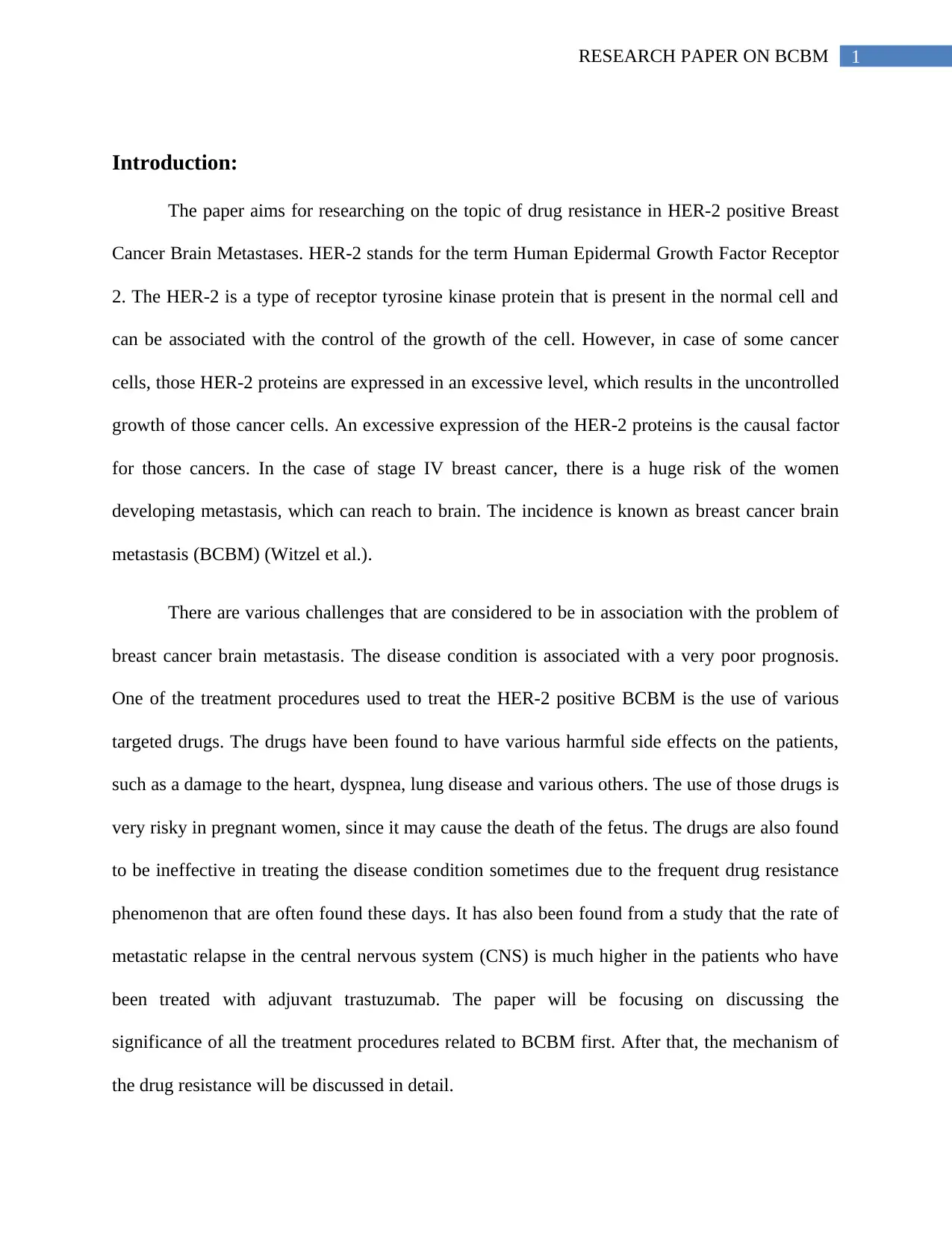
1RESEARCH PAPER ON BCBM
Introduction:
The paper aims for researching on the topic of drug resistance in HER-2 positive Breast
Cancer Brain Metastases. HER-2 stands for the term Human Epidermal Growth Factor Receptor
2. The HER-2 is a type of receptor tyrosine kinase protein that is present in the normal cell and
can be associated with the control of the growth of the cell. However, in case of some cancer
cells, those HER-2 proteins are expressed in an excessive level, which results in the uncontrolled
growth of those cancer cells. An excessive expression of the HER-2 proteins is the causal factor
for those cancers. In the case of stage IV breast cancer, there is a huge risk of the women
developing metastasis, which can reach to brain. The incidence is known as breast cancer brain
metastasis (BCBM) (Witzel et al.).
There are various challenges that are considered to be in association with the problem of
breast cancer brain metastasis. The disease condition is associated with a very poor prognosis.
One of the treatment procedures used to treat the HER-2 positive BCBM is the use of various
targeted drugs. The drugs have been found to have various harmful side effects on the patients,
such as a damage to the heart, dyspnea, lung disease and various others. The use of those drugs is
very risky in pregnant women, since it may cause the death of the fetus. The drugs are also found
to be ineffective in treating the disease condition sometimes due to the frequent drug resistance
phenomenon that are often found these days. It has also been found from a study that the rate of
metastatic relapse in the central nervous system (CNS) is much higher in the patients who have
been treated with adjuvant trastuzumab. The paper will be focusing on discussing the
significance of all the treatment procedures related to BCBM first. After that, the mechanism of
the drug resistance will be discussed in detail.
Introduction:
The paper aims for researching on the topic of drug resistance in HER-2 positive Breast
Cancer Brain Metastases. HER-2 stands for the term Human Epidermal Growth Factor Receptor
2. The HER-2 is a type of receptor tyrosine kinase protein that is present in the normal cell and
can be associated with the control of the growth of the cell. However, in case of some cancer
cells, those HER-2 proteins are expressed in an excessive level, which results in the uncontrolled
growth of those cancer cells. An excessive expression of the HER-2 proteins is the causal factor
for those cancers. In the case of stage IV breast cancer, there is a huge risk of the women
developing metastasis, which can reach to brain. The incidence is known as breast cancer brain
metastasis (BCBM) (Witzel et al.).
There are various challenges that are considered to be in association with the problem of
breast cancer brain metastasis. The disease condition is associated with a very poor prognosis.
One of the treatment procedures used to treat the HER-2 positive BCBM is the use of various
targeted drugs. The drugs have been found to have various harmful side effects on the patients,
such as a damage to the heart, dyspnea, lung disease and various others. The use of those drugs is
very risky in pregnant women, since it may cause the death of the fetus. The drugs are also found
to be ineffective in treating the disease condition sometimes due to the frequent drug resistance
phenomenon that are often found these days. It has also been found from a study that the rate of
metastatic relapse in the central nervous system (CNS) is much higher in the patients who have
been treated with adjuvant trastuzumab. The paper will be focusing on discussing the
significance of all the treatment procedures related to BCBM first. After that, the mechanism of
the drug resistance will be discussed in detail.
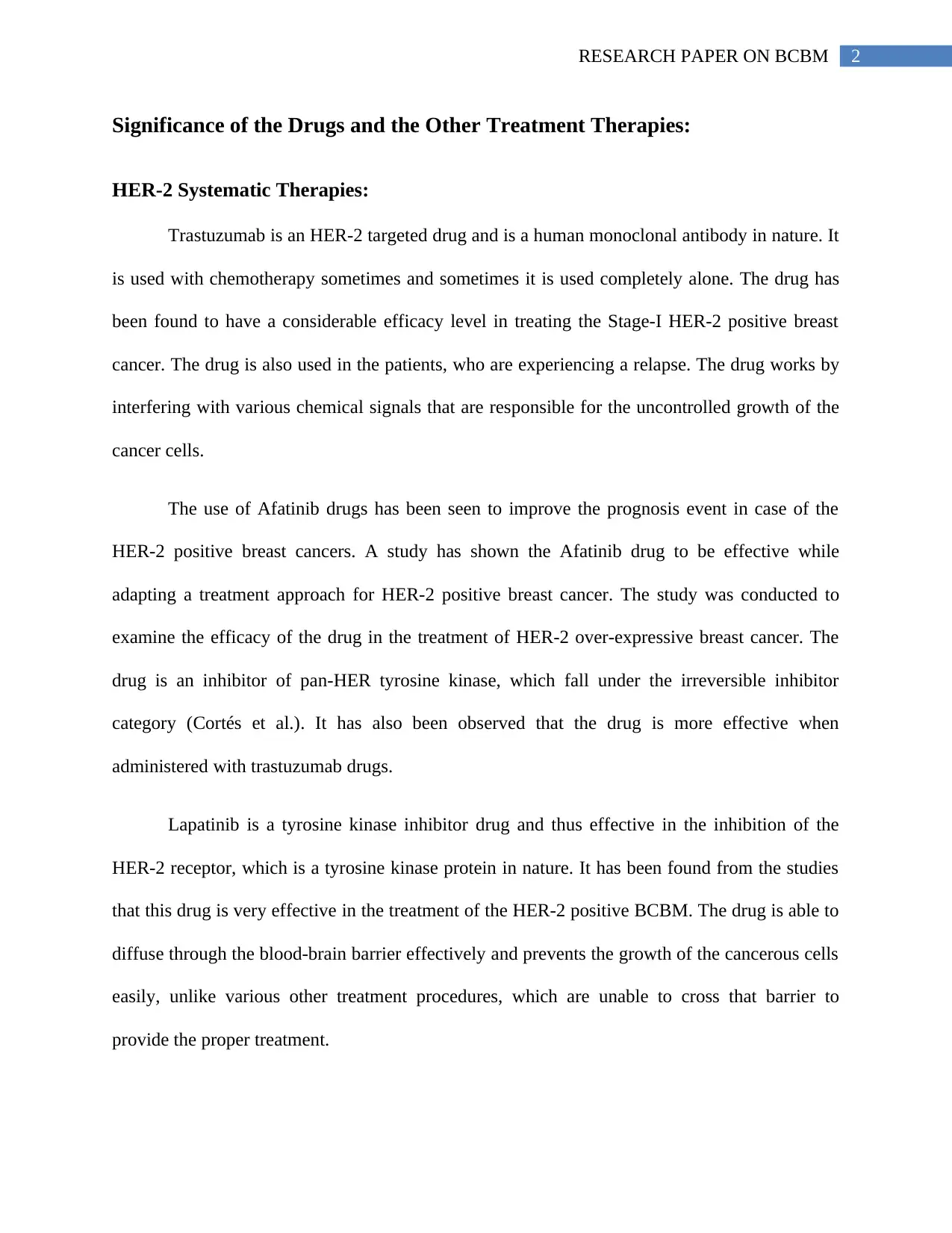
2RESEARCH PAPER ON BCBM
Significance of the Drugs and the Other Treatment Therapies:
HER-2 Systematic Therapies:
Trastuzumab is an HER-2 targeted drug and is a human monoclonal antibody in nature. It
is used with chemotherapy sometimes and sometimes it is used completely alone. The drug has
been found to have a considerable efficacy level in treating the Stage-I HER-2 positive breast
cancer. The drug is also used in the patients, who are experiencing a relapse. The drug works by
interfering with various chemical signals that are responsible for the uncontrolled growth of the
cancer cells.
The use of Afatinib drugs has been seen to improve the prognosis event in case of the
HER-2 positive breast cancers. A study has shown the Afatinib drug to be effective while
adapting a treatment approach for HER-2 positive breast cancer. The study was conducted to
examine the efficacy of the drug in the treatment of HER-2 over-expressive breast cancer. The
drug is an inhibitor of pan-HER tyrosine kinase, which fall under the irreversible inhibitor
category (Cortés et al.). It has also been observed that the drug is more effective when
administered with trastuzumab drugs.
Lapatinib is a tyrosine kinase inhibitor drug and thus effective in the inhibition of the
HER-2 receptor, which is a tyrosine kinase protein in nature. It has been found from the studies
that this drug is very effective in the treatment of the HER-2 positive BCBM. The drug is able to
diffuse through the blood-brain barrier effectively and prevents the growth of the cancerous cells
easily, unlike various other treatment procedures, which are unable to cross that barrier to
provide the proper treatment.
Significance of the Drugs and the Other Treatment Therapies:
HER-2 Systematic Therapies:
Trastuzumab is an HER-2 targeted drug and is a human monoclonal antibody in nature. It
is used with chemotherapy sometimes and sometimes it is used completely alone. The drug has
been found to have a considerable efficacy level in treating the Stage-I HER-2 positive breast
cancer. The drug is also used in the patients, who are experiencing a relapse. The drug works by
interfering with various chemical signals that are responsible for the uncontrolled growth of the
cancer cells.
The use of Afatinib drugs has been seen to improve the prognosis event in case of the
HER-2 positive breast cancers. A study has shown the Afatinib drug to be effective while
adapting a treatment approach for HER-2 positive breast cancer. The study was conducted to
examine the efficacy of the drug in the treatment of HER-2 over-expressive breast cancer. The
drug is an inhibitor of pan-HER tyrosine kinase, which fall under the irreversible inhibitor
category (Cortés et al.). It has also been observed that the drug is more effective when
administered with trastuzumab drugs.
Lapatinib is a tyrosine kinase inhibitor drug and thus effective in the inhibition of the
HER-2 receptor, which is a tyrosine kinase protein in nature. It has been found from the studies
that this drug is very effective in the treatment of the HER-2 positive BCBM. The drug is able to
diffuse through the blood-brain barrier effectively and prevents the growth of the cancerous cells
easily, unlike various other treatment procedures, which are unable to cross that barrier to
provide the proper treatment.
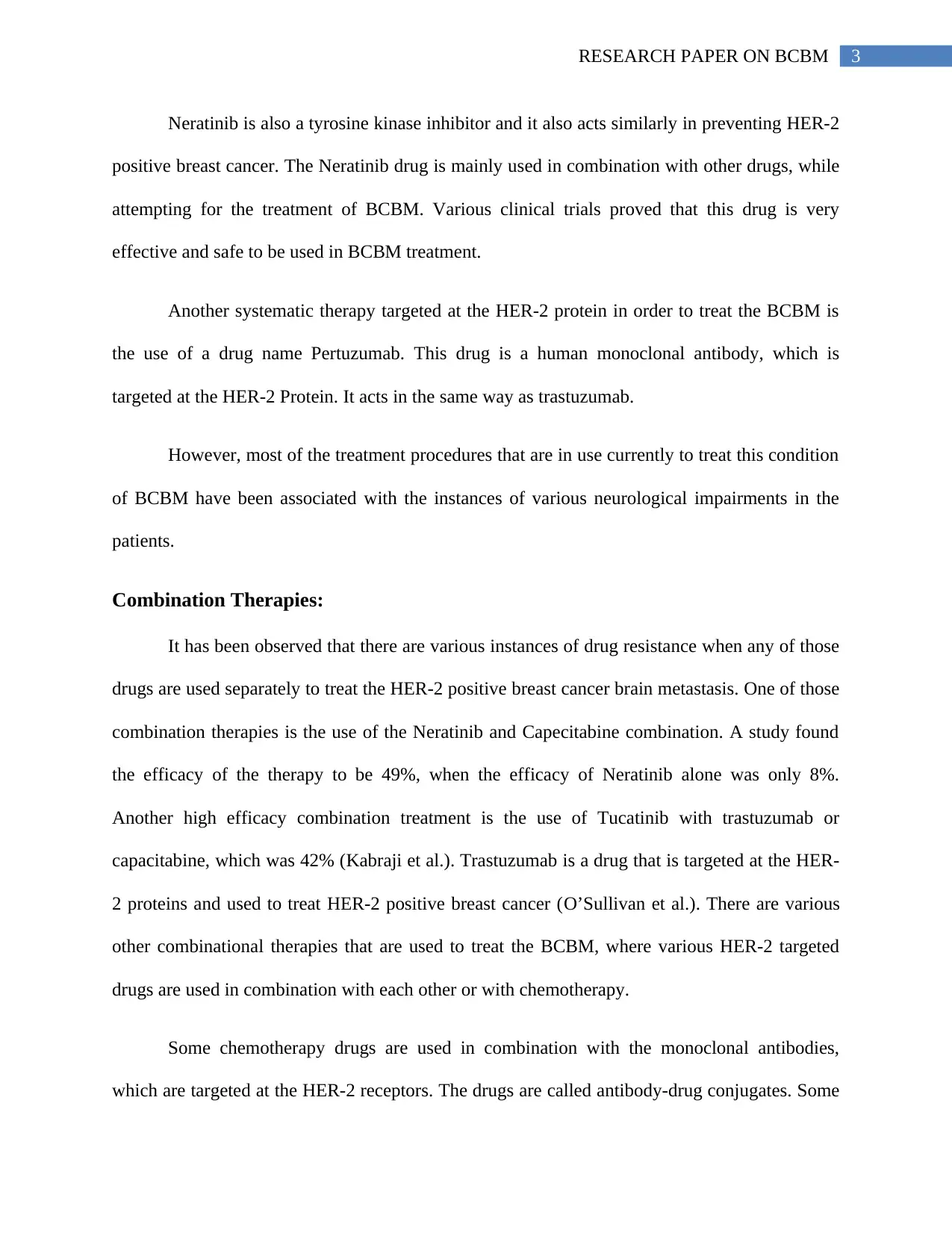
3RESEARCH PAPER ON BCBM
Neratinib is also a tyrosine kinase inhibitor and it also acts similarly in preventing HER-2
positive breast cancer. The Neratinib drug is mainly used in combination with other drugs, while
attempting for the treatment of BCBM. Various clinical trials proved that this drug is very
effective and safe to be used in BCBM treatment.
Another systematic therapy targeted at the HER-2 protein in order to treat the BCBM is
the use of a drug name Pertuzumab. This drug is a human monoclonal antibody, which is
targeted at the HER-2 Protein. It acts in the same way as trastuzumab.
However, most of the treatment procedures that are in use currently to treat this condition
of BCBM have been associated with the instances of various neurological impairments in the
patients.
Combination Therapies:
It has been observed that there are various instances of drug resistance when any of those
drugs are used separately to treat the HER-2 positive breast cancer brain metastasis. One of those
combination therapies is the use of the Neratinib and Capecitabine combination. A study found
the efficacy of the therapy to be 49%, when the efficacy of Neratinib alone was only 8%.
Another high efficacy combination treatment is the use of Tucatinib with trastuzumab or
capacitabine, which was 42% (Kabraji et al.). Trastuzumab is a drug that is targeted at the HER-
2 proteins and used to treat HER-2 positive breast cancer (O’Sullivan et al.). There are various
other combinational therapies that are used to treat the BCBM, where various HER-2 targeted
drugs are used in combination with each other or with chemotherapy.
Some chemotherapy drugs are used in combination with the monoclonal antibodies,
which are targeted at the HER-2 receptors. The drugs are called antibody-drug conjugates. Some
Neratinib is also a tyrosine kinase inhibitor and it also acts similarly in preventing HER-2
positive breast cancer. The Neratinib drug is mainly used in combination with other drugs, while
attempting for the treatment of BCBM. Various clinical trials proved that this drug is very
effective and safe to be used in BCBM treatment.
Another systematic therapy targeted at the HER-2 protein in order to treat the BCBM is
the use of a drug name Pertuzumab. This drug is a human monoclonal antibody, which is
targeted at the HER-2 Protein. It acts in the same way as trastuzumab.
However, most of the treatment procedures that are in use currently to treat this condition
of BCBM have been associated with the instances of various neurological impairments in the
patients.
Combination Therapies:
It has been observed that there are various instances of drug resistance when any of those
drugs are used separately to treat the HER-2 positive breast cancer brain metastasis. One of those
combination therapies is the use of the Neratinib and Capecitabine combination. A study found
the efficacy of the therapy to be 49%, when the efficacy of Neratinib alone was only 8%.
Another high efficacy combination treatment is the use of Tucatinib with trastuzumab or
capacitabine, which was 42% (Kabraji et al.). Trastuzumab is a drug that is targeted at the HER-
2 proteins and used to treat HER-2 positive breast cancer (O’Sullivan et al.). There are various
other combinational therapies that are used to treat the BCBM, where various HER-2 targeted
drugs are used in combination with each other or with chemotherapy.
Some chemotherapy drugs are used in combination with the monoclonal antibodies,
which are targeted at the HER-2 receptors. The drugs are called antibody-drug conjugates. Some
Secure Best Marks with AI Grader
Need help grading? Try our AI Grader for instant feedback on your assignments.
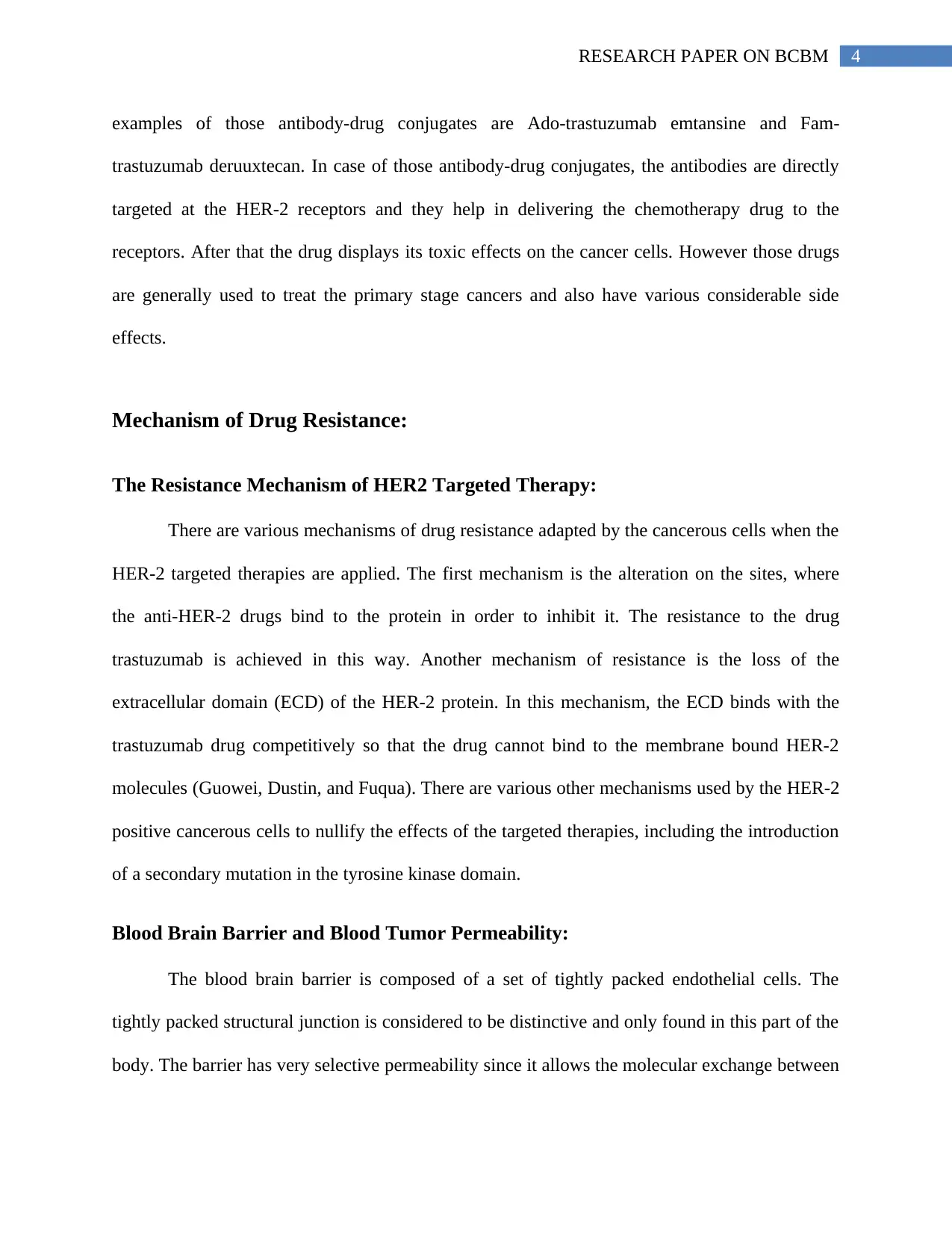
4RESEARCH PAPER ON BCBM
examples of those antibody-drug conjugates are Ado-trastuzumab emtansine and Fam-
trastuzumab deruuxtecan. In case of those antibody-drug conjugates, the antibodies are directly
targeted at the HER-2 receptors and they help in delivering the chemotherapy drug to the
receptors. After that the drug displays its toxic effects on the cancer cells. However those drugs
are generally used to treat the primary stage cancers and also have various considerable side
effects.
Mechanism of Drug Resistance:
The Resistance Mechanism of HER2 Targeted Therapy:
There are various mechanisms of drug resistance adapted by the cancerous cells when the
HER-2 targeted therapies are applied. The first mechanism is the alteration on the sites, where
the anti-HER-2 drugs bind to the protein in order to inhibit it. The resistance to the drug
trastuzumab is achieved in this way. Another mechanism of resistance is the loss of the
extracellular domain (ECD) of the HER-2 protein. In this mechanism, the ECD binds with the
trastuzumab drug competitively so that the drug cannot bind to the membrane bound HER-2
molecules (Guowei, Dustin, and Fuqua). There are various other mechanisms used by the HER-2
positive cancerous cells to nullify the effects of the targeted therapies, including the introduction
of a secondary mutation in the tyrosine kinase domain.
Blood Brain Barrier and Blood Tumor Permeability:
The blood brain barrier is composed of a set of tightly packed endothelial cells. The
tightly packed structural junction is considered to be distinctive and only found in this part of the
body. The barrier has very selective permeability since it allows the molecular exchange between
examples of those antibody-drug conjugates are Ado-trastuzumab emtansine and Fam-
trastuzumab deruuxtecan. In case of those antibody-drug conjugates, the antibodies are directly
targeted at the HER-2 receptors and they help in delivering the chemotherapy drug to the
receptors. After that the drug displays its toxic effects on the cancer cells. However those drugs
are generally used to treat the primary stage cancers and also have various considerable side
effects.
Mechanism of Drug Resistance:
The Resistance Mechanism of HER2 Targeted Therapy:
There are various mechanisms of drug resistance adapted by the cancerous cells when the
HER-2 targeted therapies are applied. The first mechanism is the alteration on the sites, where
the anti-HER-2 drugs bind to the protein in order to inhibit it. The resistance to the drug
trastuzumab is achieved in this way. Another mechanism of resistance is the loss of the
extracellular domain (ECD) of the HER-2 protein. In this mechanism, the ECD binds with the
trastuzumab drug competitively so that the drug cannot bind to the membrane bound HER-2
molecules (Guowei, Dustin, and Fuqua). There are various other mechanisms used by the HER-2
positive cancerous cells to nullify the effects of the targeted therapies, including the introduction
of a secondary mutation in the tyrosine kinase domain.
Blood Brain Barrier and Blood Tumor Permeability:
The blood brain barrier is composed of a set of tightly packed endothelial cells. The
tightly packed structural junction is considered to be distinctive and only found in this part of the
body. The barrier has very selective permeability since it allows the molecular exchange between
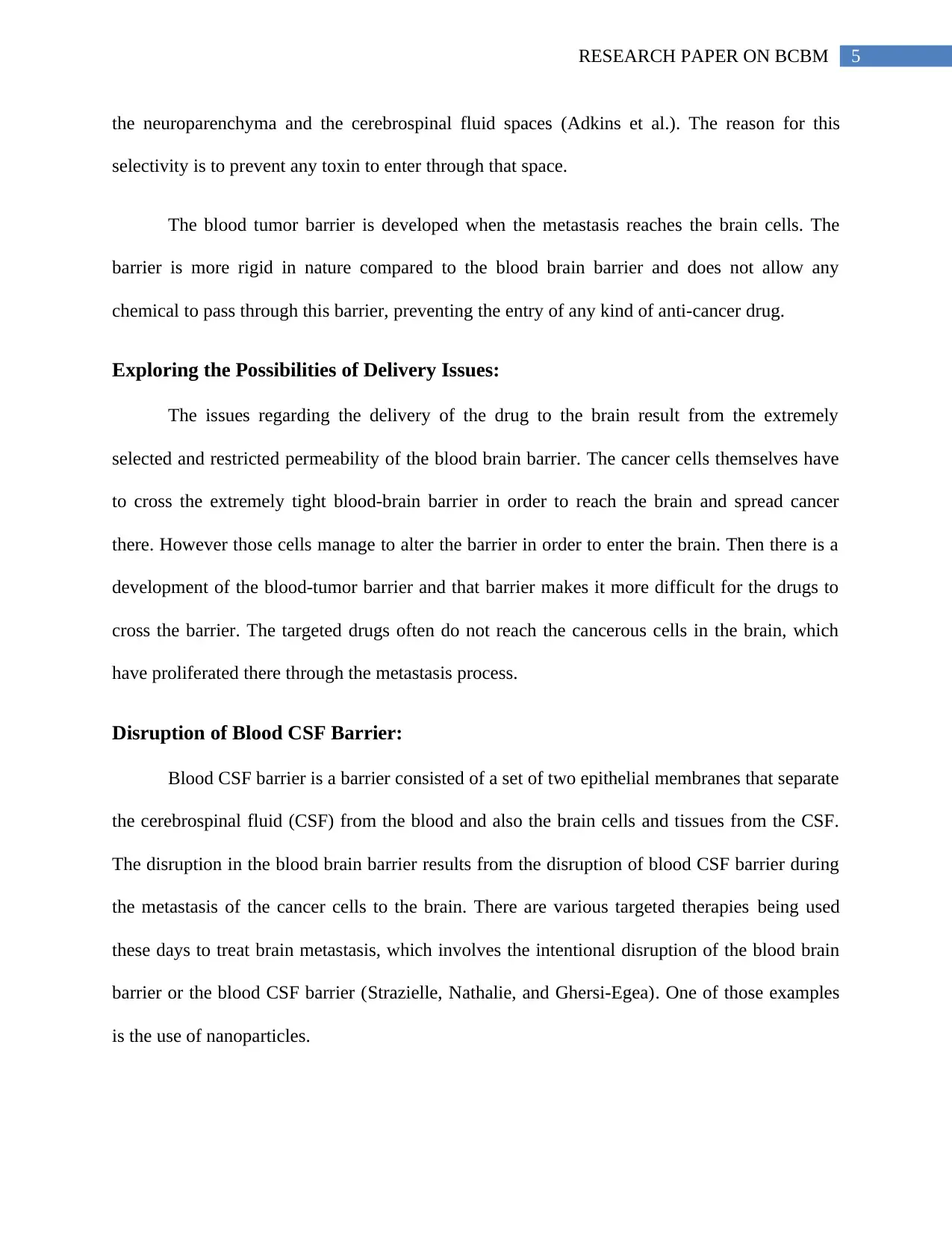
5RESEARCH PAPER ON BCBM
the neuroparenchyma and the cerebrospinal fluid spaces (Adkins et al.). The reason for this
selectivity is to prevent any toxin to enter through that space.
The blood tumor barrier is developed when the metastasis reaches the brain cells. The
barrier is more rigid in nature compared to the blood brain barrier and does not allow any
chemical to pass through this barrier, preventing the entry of any kind of anti-cancer drug.
Exploring the Possibilities of Delivery Issues:
The issues regarding the delivery of the drug to the brain result from the extremely
selected and restricted permeability of the blood brain barrier. The cancer cells themselves have
to cross the extremely tight blood-brain barrier in order to reach the brain and spread cancer
there. However those cells manage to alter the barrier in order to enter the brain. Then there is a
development of the blood-tumor barrier and that barrier makes it more difficult for the drugs to
cross the barrier. The targeted drugs often do not reach the cancerous cells in the brain, which
have proliferated there through the metastasis process.
Disruption of Blood CSF Barrier:
Blood CSF barrier is a barrier consisted of a set of two epithelial membranes that separate
the cerebrospinal fluid (CSF) from the blood and also the brain cells and tissues from the CSF.
The disruption in the blood brain barrier results from the disruption of blood CSF barrier during
the metastasis of the cancer cells to the brain. There are various targeted therapies being used
these days to treat brain metastasis, which involves the intentional disruption of the blood brain
barrier or the blood CSF barrier (Strazielle, Nathalie, and Ghersi-Egea). One of those examples
is the use of nanoparticles.
the neuroparenchyma and the cerebrospinal fluid spaces (Adkins et al.). The reason for this
selectivity is to prevent any toxin to enter through that space.
The blood tumor barrier is developed when the metastasis reaches the brain cells. The
barrier is more rigid in nature compared to the blood brain barrier and does not allow any
chemical to pass through this barrier, preventing the entry of any kind of anti-cancer drug.
Exploring the Possibilities of Delivery Issues:
The issues regarding the delivery of the drug to the brain result from the extremely
selected and restricted permeability of the blood brain barrier. The cancer cells themselves have
to cross the extremely tight blood-brain barrier in order to reach the brain and spread cancer
there. However those cells manage to alter the barrier in order to enter the brain. Then there is a
development of the blood-tumor barrier and that barrier makes it more difficult for the drugs to
cross the barrier. The targeted drugs often do not reach the cancerous cells in the brain, which
have proliferated there through the metastasis process.
Disruption of Blood CSF Barrier:
Blood CSF barrier is a barrier consisted of a set of two epithelial membranes that separate
the cerebrospinal fluid (CSF) from the blood and also the brain cells and tissues from the CSF.
The disruption in the blood brain barrier results from the disruption of blood CSF barrier during
the metastasis of the cancer cells to the brain. There are various targeted therapies being used
these days to treat brain metastasis, which involves the intentional disruption of the blood brain
barrier or the blood CSF barrier (Strazielle, Nathalie, and Ghersi-Egea). One of those examples
is the use of nanoparticles.
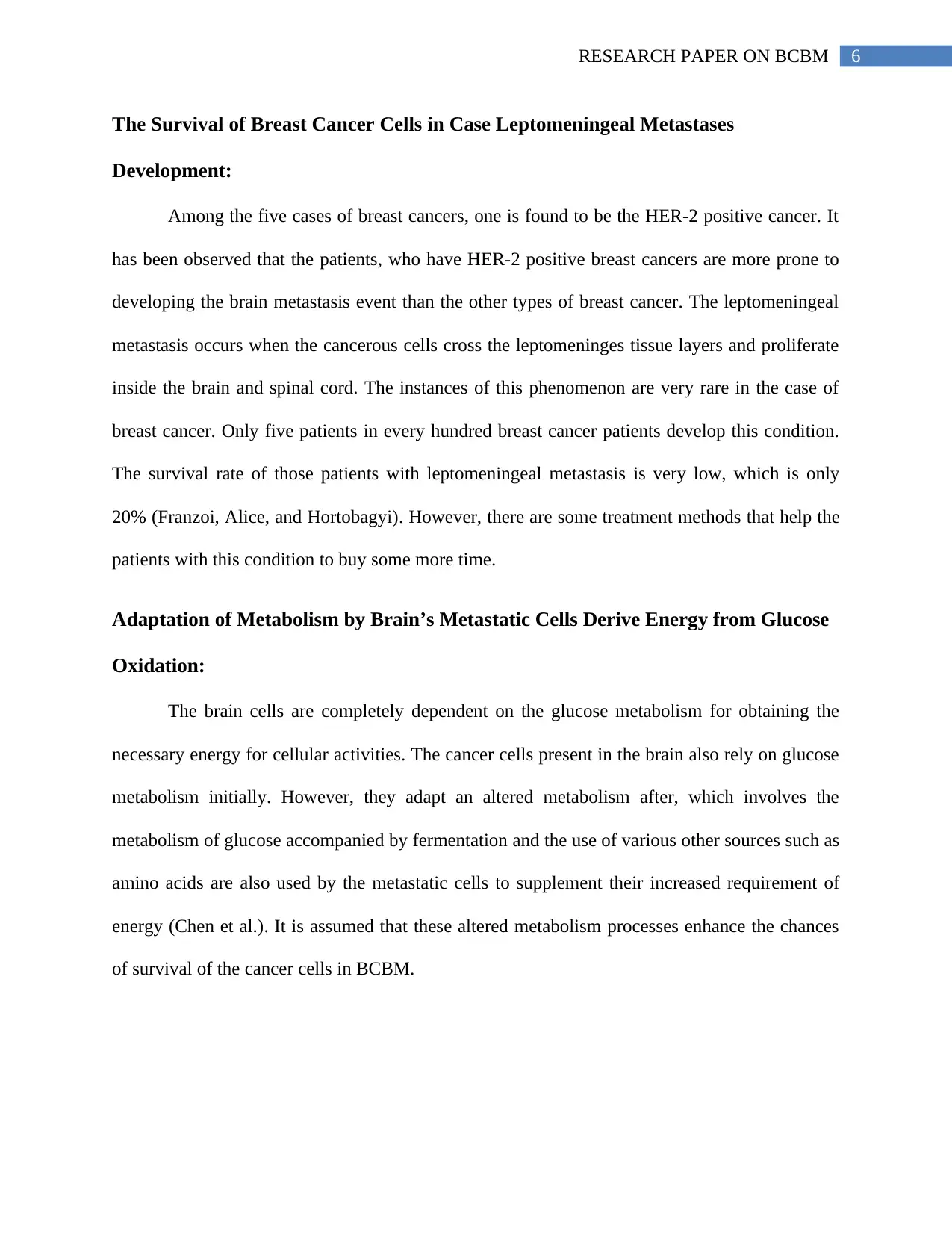
6RESEARCH PAPER ON BCBM
The Survival of Breast Cancer Cells in Case Leptomeningeal Metastases
Development:
Among the five cases of breast cancers, one is found to be the HER-2 positive cancer. It
has been observed that the patients, who have HER-2 positive breast cancers are more prone to
developing the brain metastasis event than the other types of breast cancer. The leptomeningeal
metastasis occurs when the cancerous cells cross the leptomeninges tissue layers and proliferate
inside the brain and spinal cord. The instances of this phenomenon are very rare in the case of
breast cancer. Only five patients in every hundred breast cancer patients develop this condition.
The survival rate of those patients with leptomeningeal metastasis is very low, which is only
20% (Franzoi, Alice, and Hortobagyi). However, there are some treatment methods that help the
patients with this condition to buy some more time.
Adaptation of Metabolism by Brain’s Metastatic Cells Derive Energy from Glucose
Oxidation:
The brain cells are completely dependent on the glucose metabolism for obtaining the
necessary energy for cellular activities. The cancer cells present in the brain also rely on glucose
metabolism initially. However, they adapt an altered metabolism after, which involves the
metabolism of glucose accompanied by fermentation and the use of various other sources such as
amino acids are also used by the metastatic cells to supplement their increased requirement of
energy (Chen et al.). It is assumed that these altered metabolism processes enhance the chances
of survival of the cancer cells in BCBM.
The Survival of Breast Cancer Cells in Case Leptomeningeal Metastases
Development:
Among the five cases of breast cancers, one is found to be the HER-2 positive cancer. It
has been observed that the patients, who have HER-2 positive breast cancers are more prone to
developing the brain metastasis event than the other types of breast cancer. The leptomeningeal
metastasis occurs when the cancerous cells cross the leptomeninges tissue layers and proliferate
inside the brain and spinal cord. The instances of this phenomenon are very rare in the case of
breast cancer. Only five patients in every hundred breast cancer patients develop this condition.
The survival rate of those patients with leptomeningeal metastasis is very low, which is only
20% (Franzoi, Alice, and Hortobagyi). However, there are some treatment methods that help the
patients with this condition to buy some more time.
Adaptation of Metabolism by Brain’s Metastatic Cells Derive Energy from Glucose
Oxidation:
The brain cells are completely dependent on the glucose metabolism for obtaining the
necessary energy for cellular activities. The cancer cells present in the brain also rely on glucose
metabolism initially. However, they adapt an altered metabolism after, which involves the
metabolism of glucose accompanied by fermentation and the use of various other sources such as
amino acids are also used by the metastatic cells to supplement their increased requirement of
energy (Chen et al.). It is assumed that these altered metabolism processes enhance the chances
of survival of the cancer cells in BCBM.
Paraphrase This Document
Need a fresh take? Get an instant paraphrase of this document with our AI Paraphraser
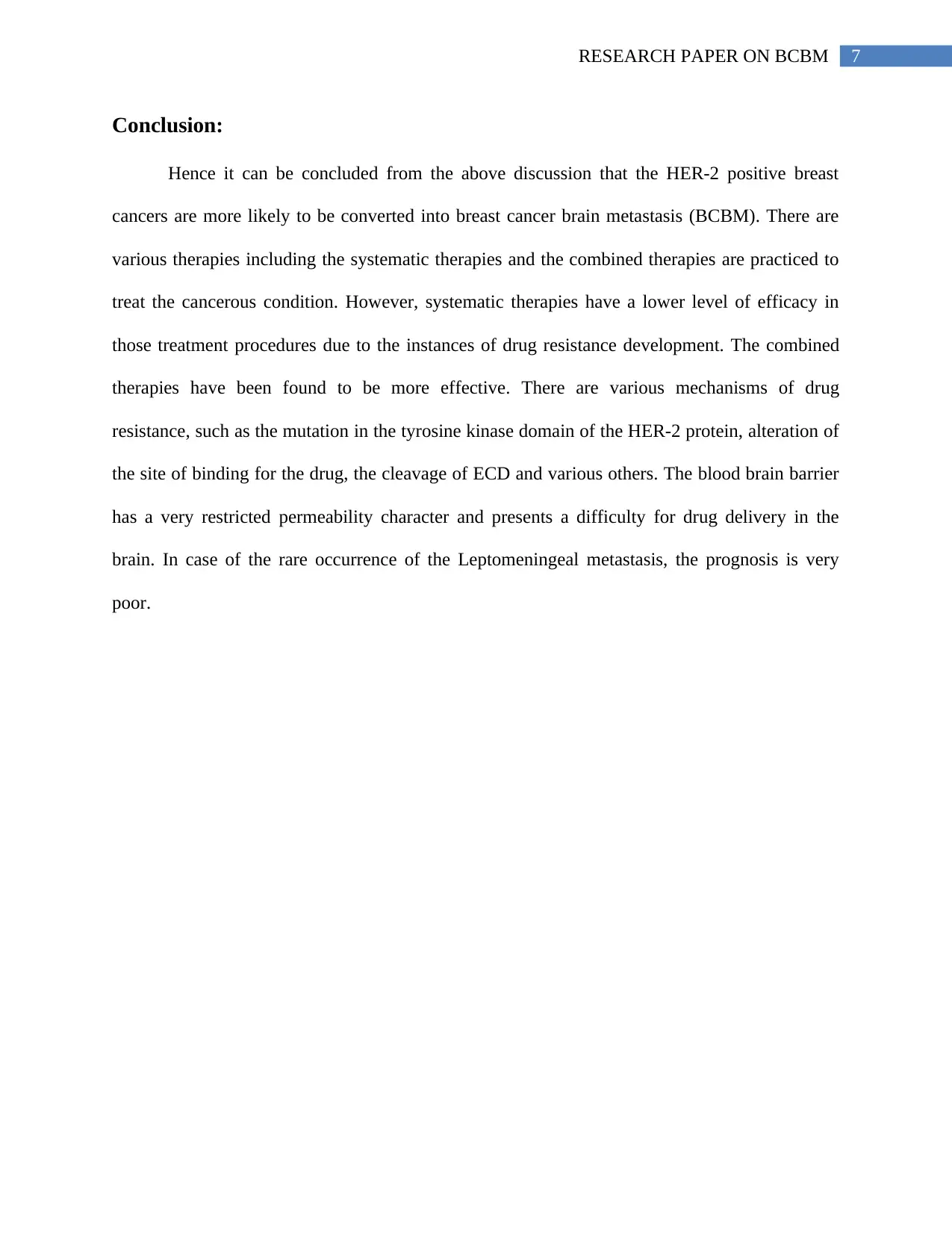
7RESEARCH PAPER ON BCBM
Conclusion:
Hence it can be concluded from the above discussion that the HER-2 positive breast
cancers are more likely to be converted into breast cancer brain metastasis (BCBM). There are
various therapies including the systematic therapies and the combined therapies are practiced to
treat the cancerous condition. However, systematic therapies have a lower level of efficacy in
those treatment procedures due to the instances of drug resistance development. The combined
therapies have been found to be more effective. There are various mechanisms of drug
resistance, such as the mutation in the tyrosine kinase domain of the HER-2 protein, alteration of
the site of binding for the drug, the cleavage of ECD and various others. The blood brain barrier
has a very restricted permeability character and presents a difficulty for drug delivery in the
brain. In case of the rare occurrence of the Leptomeningeal metastasis, the prognosis is very
poor.
Conclusion:
Hence it can be concluded from the above discussion that the HER-2 positive breast
cancers are more likely to be converted into breast cancer brain metastasis (BCBM). There are
various therapies including the systematic therapies and the combined therapies are practiced to
treat the cancerous condition. However, systematic therapies have a lower level of efficacy in
those treatment procedures due to the instances of drug resistance development. The combined
therapies have been found to be more effective. There are various mechanisms of drug
resistance, such as the mutation in the tyrosine kinase domain of the HER-2 protein, alteration of
the site of binding for the drug, the cleavage of ECD and various others. The blood brain barrier
has a very restricted permeability character and presents a difficulty for drug delivery in the
brain. In case of the rare occurrence of the Leptomeningeal metastasis, the prognosis is very
poor.
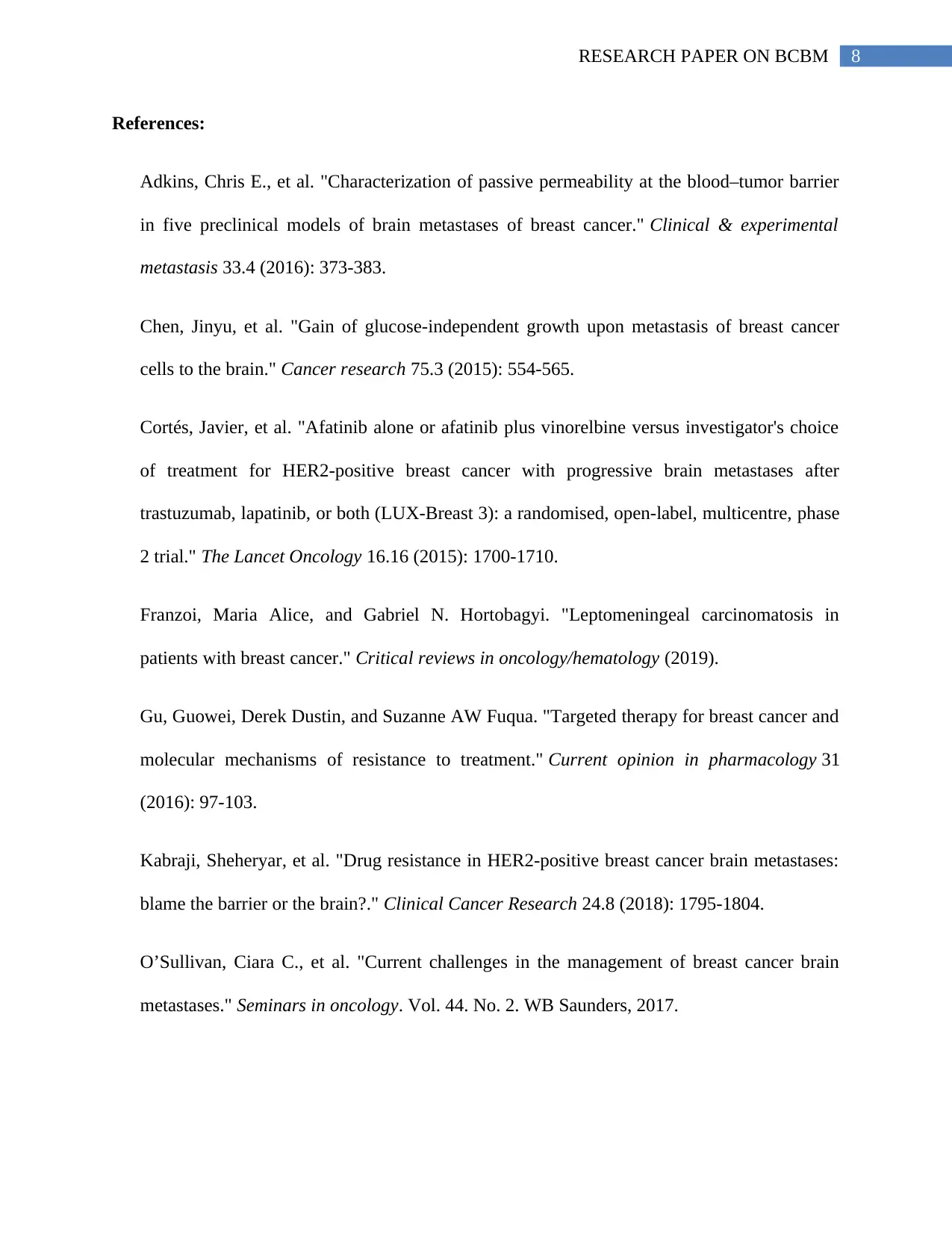
8RESEARCH PAPER ON BCBM
References:
Adkins, Chris E., et al. "Characterization of passive permeability at the blood–tumor barrier
in five preclinical models of brain metastases of breast cancer." Clinical & experimental
metastasis 33.4 (2016): 373-383.
Chen, Jinyu, et al. "Gain of glucose-independent growth upon metastasis of breast cancer
cells to the brain." Cancer research 75.3 (2015): 554-565.
Cortés, Javier, et al. "Afatinib alone or afatinib plus vinorelbine versus investigator's choice
of treatment for HER2-positive breast cancer with progressive brain metastases after
trastuzumab, lapatinib, or both (LUX-Breast 3): a randomised, open-label, multicentre, phase
2 trial." The Lancet Oncology 16.16 (2015): 1700-1710.
Franzoi, Maria Alice, and Gabriel N. Hortobagyi. "Leptomeningeal carcinomatosis in
patients with breast cancer." Critical reviews in oncology/hematology (2019).
Gu, Guowei, Derek Dustin, and Suzanne AW Fuqua. "Targeted therapy for breast cancer and
molecular mechanisms of resistance to treatment." Current opinion in pharmacology 31
(2016): 97-103.
Kabraji, Sheheryar, et al. "Drug resistance in HER2-positive breast cancer brain metastases:
blame the barrier or the brain?." Clinical Cancer Research 24.8 (2018): 1795-1804.
O’Sullivan, Ciara C., et al. "Current challenges in the management of breast cancer brain
metastases." Seminars in oncology. Vol. 44. No. 2. WB Saunders, 2017.
References:
Adkins, Chris E., et al. "Characterization of passive permeability at the blood–tumor barrier
in five preclinical models of brain metastases of breast cancer." Clinical & experimental
metastasis 33.4 (2016): 373-383.
Chen, Jinyu, et al. "Gain of glucose-independent growth upon metastasis of breast cancer
cells to the brain." Cancer research 75.3 (2015): 554-565.
Cortés, Javier, et al. "Afatinib alone or afatinib plus vinorelbine versus investigator's choice
of treatment for HER2-positive breast cancer with progressive brain metastases after
trastuzumab, lapatinib, or both (LUX-Breast 3): a randomised, open-label, multicentre, phase
2 trial." The Lancet Oncology 16.16 (2015): 1700-1710.
Franzoi, Maria Alice, and Gabriel N. Hortobagyi. "Leptomeningeal carcinomatosis in
patients with breast cancer." Critical reviews in oncology/hematology (2019).
Gu, Guowei, Derek Dustin, and Suzanne AW Fuqua. "Targeted therapy for breast cancer and
molecular mechanisms of resistance to treatment." Current opinion in pharmacology 31
(2016): 97-103.
Kabraji, Sheheryar, et al. "Drug resistance in HER2-positive breast cancer brain metastases:
blame the barrier or the brain?." Clinical Cancer Research 24.8 (2018): 1795-1804.
O’Sullivan, Ciara C., et al. "Current challenges in the management of breast cancer brain
metastases." Seminars in oncology. Vol. 44. No. 2. WB Saunders, 2017.
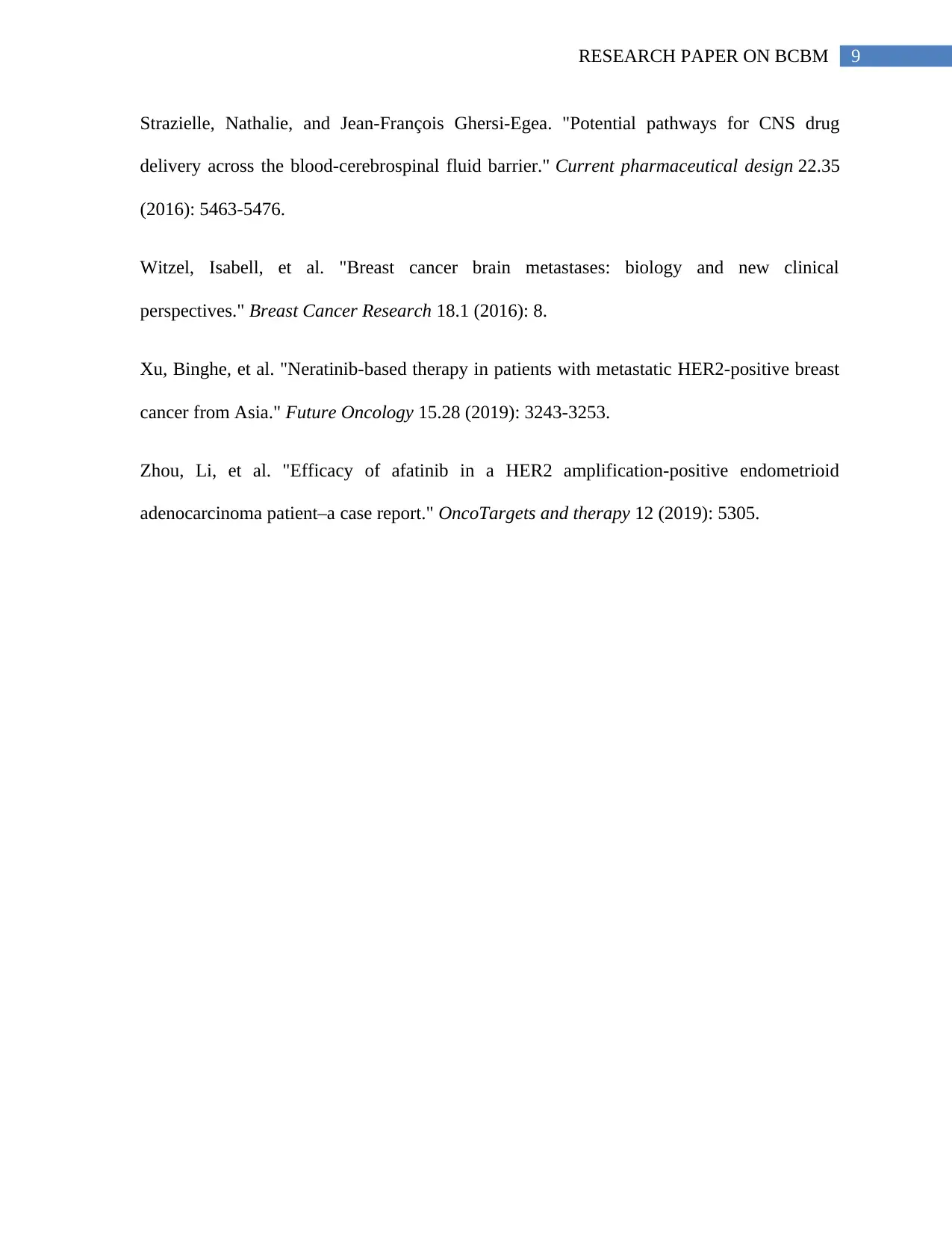
9RESEARCH PAPER ON BCBM
Strazielle, Nathalie, and Jean-François Ghersi-Egea. "Potential pathways for CNS drug
delivery across the blood-cerebrospinal fluid barrier." Current pharmaceutical design 22.35
(2016): 5463-5476.
Witzel, Isabell, et al. "Breast cancer brain metastases: biology and new clinical
perspectives." Breast Cancer Research 18.1 (2016): 8.
Xu, Binghe, et al. "Neratinib-based therapy in patients with metastatic HER2-positive breast
cancer from Asia." Future Oncology 15.28 (2019): 3243-3253.
Zhou, Li, et al. "Efficacy of afatinib in a HER2 amplification-positive endometrioid
adenocarcinoma patient–a case report." OncoTargets and therapy 12 (2019): 5305.
Strazielle, Nathalie, and Jean-François Ghersi-Egea. "Potential pathways for CNS drug
delivery across the blood-cerebrospinal fluid barrier." Current pharmaceutical design 22.35
(2016): 5463-5476.
Witzel, Isabell, et al. "Breast cancer brain metastases: biology and new clinical
perspectives." Breast Cancer Research 18.1 (2016): 8.
Xu, Binghe, et al. "Neratinib-based therapy in patients with metastatic HER2-positive breast
cancer from Asia." Future Oncology 15.28 (2019): 3243-3253.
Zhou, Li, et al. "Efficacy of afatinib in a HER2 amplification-positive endometrioid
adenocarcinoma patient–a case report." OncoTargets and therapy 12 (2019): 5305.
1 out of 10
Related Documents
Your All-in-One AI-Powered Toolkit for Academic Success.
+13062052269
info@desklib.com
Available 24*7 on WhatsApp / Email
![[object Object]](/_next/static/media/star-bottom.7253800d.svg)
Unlock your academic potential
© 2024 | Zucol Services PVT LTD | All rights reserved.





